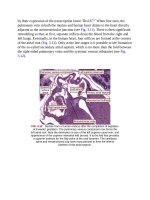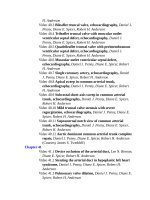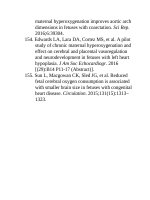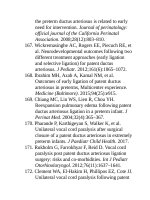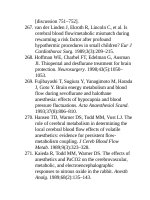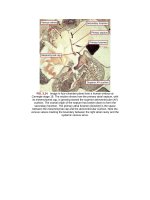Andersons pediatric cardiology 1087
Bạn đang xem bản rút gọn của tài liệu. Xem và tải ngay bản đầy đủ của tài liệu tại đây (101.1 KB, 3 trang )
syndrome.105Ductalclosureusuallybeginsatthepulmonaryarterialendofthe
vessel,andifclosureattheaorticendfailstooccur,itbecomesineffectan
aorticdiverticulumundersystemicpressure.Althoughformationofsucha
diverticulumiscommon,itislessclearwhythisoccasionallyprogressesto
aneurysmalformation.Structuralabnormalitiesarepossiblypresentintheaortic
butnotthepulmonaryendoftheduct,suchasthoseassociatedwithcollagen
vasculardisorders.Sepsismaybeinvolvedinthepathogenesisofsomecasesin
infancy.Adiverticulumarisingfromthepulmonarytrunkisalsocommon.
Usually,thetypefoundininfancyisasymptomaticandmaynotbeuncovered
untilautopsyfordeathfromothercauses.Itpresentsasatumorlikeleft-sided
mediastinalmass.In20%ofcases,ruptureorembolismleadstodeath.
Dissectionandinfectionmayalsooccur.Regressioncanoccur,presumablydue
tothrombosisandorganization,butprogressiveenlargement,ortheonsetof
hoarseness(Ortnersyndrome)becauseofdamagetotherecurrentlaryngeal
nerveorleftbronchialobstruction,isanindicationforsurgicalexcision.110In
viewofthefrequencyoflife-threateningcomplications,promptsurgicalremoval
isadvisable.Percutaneousocclusionoftheaneurysmhasnotbeenestablished,
butapotentialapproachisplacementofacoveredstentintheaortatoexclude
theaneurysmandoccludetheduct.111Aneurysmoftheductisevenmore
uncommoninadults.112Theductmaybepatentatbothendsbutisusually
closedatthepulmonaryarterialend.113–115Possiblepathogenicmechanisms
includearrestedclosure,withpersistenceofanaorticdiverticulum,delayed
spontaneousclosureofthepulmonaryarterialend,infectivearteritisandexternal
traumainapatientwithapersistentduct,116orevencoilocclusionofa
preexistingpatentduct.117Ananeurysmoftheductshouldbeconsideredinthe
differentialdiagnosisoftheadultwithunexplainedmediastinalmassesseenon
chestradiography.Thediagnosiscanbeconfirmedbyaortographyorby
computerizedtomography.109,111–119Likethepatternseenininfancy,thehigh
incidenceofrupture,embolization,andeffectsofpressuresuggestthatsurgical
excisionisadvisable.Surgicalligationmayitselfbefollowedbyaneurysmal
formation,112,120oftenassociatedwithrecanalization.
FIG.41.15 Anteroposteriorretrogradeaortogramshowingaductal
aneurysm.Notetheassociatedmoderateaorticinsufficiency.
Thromboembolism
Thrombosisoftheductasasourceofneonatalemboluswasfirstdescribedin
1859.121Severalcases,mostlyfatal,havesincebeennoted.122,123Early
diagnosiscanprovideanopportunityforsuccessfulintervention,whichmay
includethrombectomy,heparin,andresectionofinfarctedtissue.
Treatment
Oncethediagnosisofuncomplicatedpersistentpatencyofthearterialductis
established,eliminationoftheshuntshouldberecommendedbycatheter
occlusionorsurgery.Thejustificationforclosureofsmallcommunications
residesinthepreventionofinfectiveendarteritis,coupledwithanextremelylow
proceduralmorbidityandmortality.Asnotedearlier,inthesettingofthesocalledsilentduct,thereislittleclinicalevidencetojustifyanyinterventionor
recommendationtoprescribecoverageagainstsubacutebacterial
endocarditis.124Intheoccasionalpatientwhodevelopscongestiveheartfailure,
excludingthosepatientstobediscussedlaterinthecontextofprematurity,drugs
shouldbeadministeredtocombatthefailurebutonlyuntilinterventioncan
convenientlybearranged.
SurgicalIntervention
In1939RobertGrossperformedthefirstsuccessfulligationofapersistent
arterialductina7-year-oldgirl.12,125Theductisusuallyapproachedthrougha
leftposterolateralincision,usingthethirdinterspaceininfantsandthefourth
spaceinchildrenolderthan1year.Uncommonly,theductisontherightside,
especiallyinthepresenceofarightaorticarch.Itmustbeapproachedfromthe
right.Theductmaybeligatedordivided.Therelativemeritsofeachprocedure
continuetobehotlydebatedbysurgeons.Excellentresultshavebeenreported
usingbothprocedures.Theincidenceofclinicallyapparentrecanalizationwith
ligationisapproximately1%,126–129albeitthatecho-Dopplerstudieshave
detectedflowafterligationinclinicallysilentducts,suggestingtheincidenceof
residualflowtobehigher.130Largeductsexceeding7to10mmindiameter,or
thoseassociatedwithpulmonaryhypertension,aregenerallydivided.Mortality
reportedfromalargeexperienceextendingover25yearsforclosureofthe
uncomplicatedductwasnomorethan0.2%,131withafigureof0.5%citedin
anotherseries.132Oncethesafetyoftheoperationwasestablishedinolder
childrenandadults,itwasnaturalforsurgeonstoattemptclosureininfancy,133
withMustardalreadyin1951reportingsuccessfulligationinfourinfants.134
Manysurgeonsdemonstratedtheeasewithwhichtheductcouldbeligated,even
inthosebornprematurely.135Inmostunits,surgicalligationisreservedforthose
prematureinfantswhohavefailedanadequatecourseofindomethacinorwhen
therearecontraindicationstoitsadministration.However,treatmentofthe
arterialductiscontentious,rangingfromearlytargetedtreatment,late
(symptomatic)treatment,tonotreatmentatall(seelater).136Whenperformed,
surgicalligationcanbedoneatbedside.Theneedforaccurateanatomic
definitionpriortointerventionintheprematureinfantmustbeunderscored.137
Complicationsareuncommon.Injurytotherecurrentlaryngealnerveinjury
canoccuroccasionallybutisusuallytemporary,138althoughitcanbepermanent.
Rarely,afalseaneurysmmaydevelop,promptingurgentsurgicalreoperation
afterligation.139Damagetothephrenicnervehasalsobeenreported,occurring
mostfrequentlyintheprematureinfant.Chylothoraxcanalsooccur.Inadvertent
ligationofthedistalleftpulmonaryarteryoccursinfrequently.Thisisahazard
